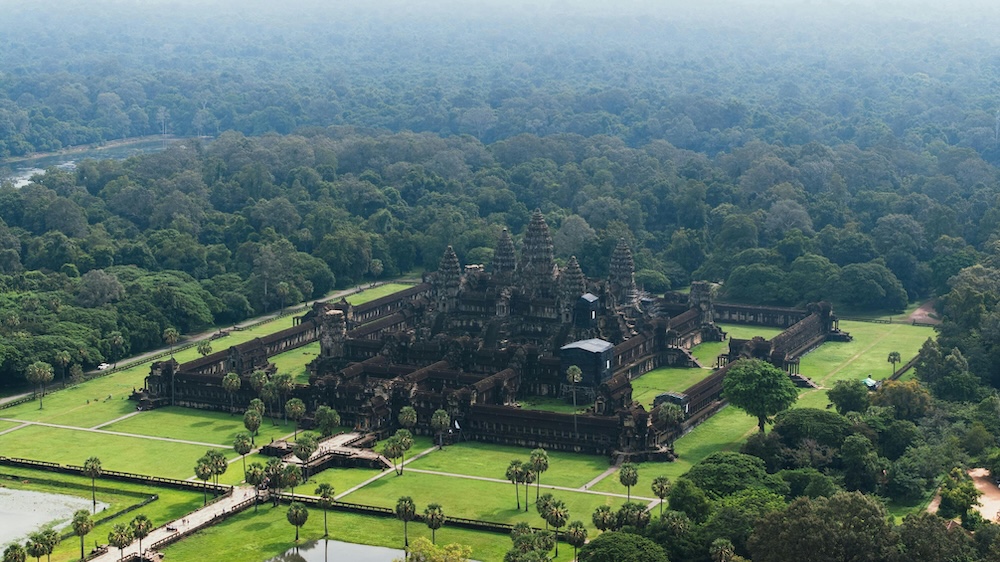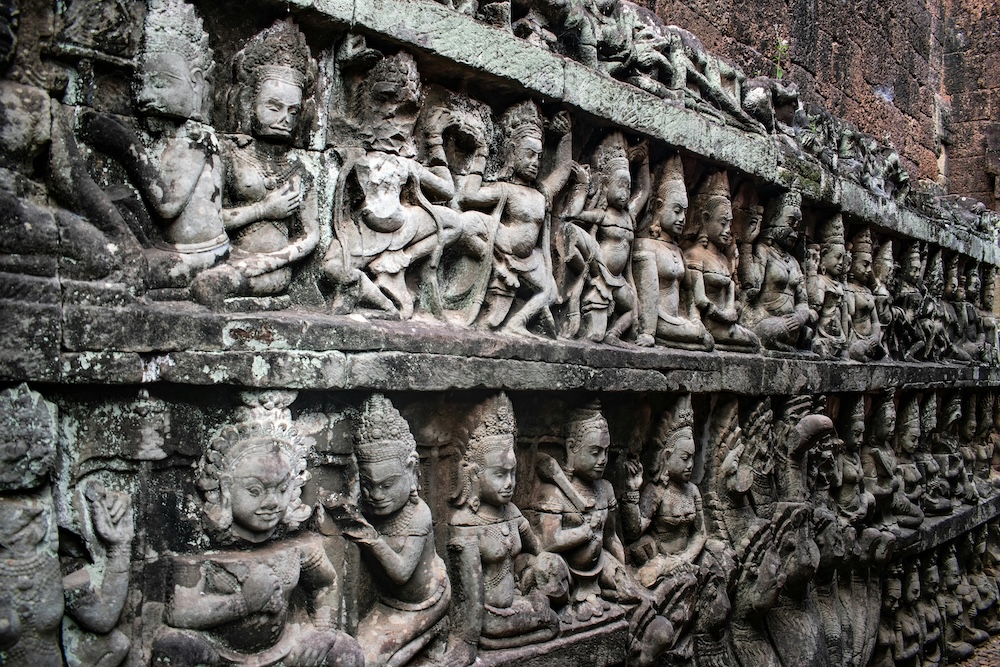There is a temple complex deep in Cambodia's untouched jungle that was built with four times as much stone as the pyramids. The stones shine when touched and the buildings seem to "float" on water. Angkor Wat is one of the biggest and most mysterious cities in history. Recent laser scans have uncovered amazing secrets about this lost city and the incredible engineering feats that have kept it standing for almost a thousand years.
The European "Discovery" and Early Wonder
The story of how Angkor Wat became known in the West starts with António da Madalena, a Portuguese explorer who went there in 1586. This Capuchin friar was the first person from the West to write about Angkor. He traveled overland from Goa to Cambodia. He told historian Diogo do Couto a vivid story about the beautiful buildings he saw. Madalena said that the structure was so amazing that words couldn't do it justice, and she pointed out that no civilization before had built anything like it. He correctly said that the advanced architecture came from India, which is very different from what people in Europe thought at the time, which was that Angkor was built by people like Alexander the Great.
But at the time, people in Europe didn't take António da Madalena's writing seriously, and it was mostly ignored for hundreds of years. It would take almost 300 years for another explorer to bring Angkor back into the West's view.

French naturalist Henri Mouhot left London on April 27, 1858, at the age of 31. He was inspired by Madalena's earlier writings and set out on an expedition to Southeast Asia. It took him three years to get to Angkor Wat, mostly because he was looking for strange insects in the area in 1860. It had a deep effect on him. Mouhot wrote in his diary that finding this temple was like finding an oasis in the desert, coming out of the dark into the light. He said it was "the magnificence of Solomon's holy temple combined with the artistic genius of Michelangelo, far surpassing everything ancient Greece and Rome had left us."
Mouhot couldn't understand how such a huge building could have been made so perfectly. He was amazed by the fine craftsmanship, intricate patterns, and reliefs. The scale was so huge that he wondered which civilization could make such beautiful art and, more importantly, who moved millions of stones to this place in the middle of tropical forests and swamps.
Sadly, the young explorer died of fever in Laos in 1861, just after making the discovery that he had devoted his life to. But because of his detailed notes and drawings, Western archaeologists suddenly flocked to the area and started uncovering the mysteries of this human heritage.
How Did People Measure Time in Ancient Times and What Did Hindu Cosmology Say?
When archaeologists got there in the early 1900s, they found that the area was covered in thick vegetation. They found more interesting things as they cleared it. They figured out that this huge 400-hectare area wasn't just a temple; it was also a place to live. The perfect rectangular water basin that surrounded the area was made by people. It was 1.5 kilometers long on the long sides and 1.2 kilometers long on the short sides. It was a huge artificial lake that was 4 meters deep.
In ancient cultures, water was very important, and Angkor Wat is a good example of this in Hinduism. The big lake at the entrance was an artificial channel that Hindus used to wash and clean themselves before going up the stairs to the temple. Muslim ablutions, Christian baptisms, and pagan river baths before rituals all use water to clean themselves in similar ways.
Every inch of the temple was perfectly carved, with huge halls that connected to each other, huge columns that held up the huge building, and designs that were inspired by Hindu mythology. For example, 200-meter-long relief carvings show Hindu ideas of heaven and hell, which are similar to Islamic ideas. Hindus don't think of heaven and hell as places where people stay forever, though. Instead, doing good things in this life can lead to going to Hell or Heaven in the next life. Even if you go to Hell, doing good things there can bring you back to Heaven. Life goes through good and bad cycles over and over again until someone breaks the cycle and reaches Nirvana.

The reliefs show demons in Hell who are in charge of making people who hurt others in their past lives do the same things again. For instance, if someone put a peg on a cow's nose in a past life and dragged it around, causing pain, Hell would punish them in the same way by tying a ring around their mouth. When someone dies, they are judged on Earth. If they are a sinner, they go to Hell, where they are tortured. Heaven, on the other hand, has fun things to do, bigger houses, and more money.
The 2012 LiDAR Revolution: Revealing the Secret City
Restoration work in Angkor Wat moved quickly through the 20th century. At the same time, records from a Chinese diplomat's year-long stay in the area in the 13th century came to light. Emperor Temür Khan sent Zhou Daguan on a diplomatic mission to Angkor in August 1296. He stayed there until July 1297. He said that the area was the biggest and most crowded city he had ever seen, and he talked about a huge trade city built with a system of canals. The diplomat's claim that Angkor Wat was very large was not true, so French restoration experts ignored these notes at first.
But Zhou Daguan's accuracy would be proven in the years to come, especially with the advent of LiDAR (Light Detection and Ranging) technology. Australian archaeologists Roland Fletcher and Damian Evans chose to scan the area from above with LiDAR technology in 2012. What they found shocked the whole scientific community. Angkor Wat was only a small part of a very big city.
Archaeologists used to think that places like the Bayon Temple and Ta Prohm Temple were not connected, but they now know that they were some of the most important parts of this huge city. The Bayon Temple was actually the center of this area. LiDAR found another settlement near Angkor Wat that was about five times bigger than Angkor Thom. There was also a man-made water basin around this 9-kilometer area. It was 13 kilometers long, 100 meters wide, and 4 meters deep.
LiDAR showed more than just the area's forests. It showed that there were thousands of canals buried under the ground that held hundreds of temples that trees had swallowed. Zhou Daguan was indeed right. Around 1,000 years ago, the Angkor region was a self-sufficient green city with a population of about 750,000 to 900,000 people. If you think about how big the area was compared to London, which was one of the biggest cities in Europe at the time and only had about 50,000 people living there, you'll get a better idea of how big it was.
These canals, which were connected by thousands of water channels like Venice, were used for more than just getting around. They also brought water to people's small fields in front of their homes. In lower-class areas, they were used as common pools, but in upper-class areas, they were used as private pools and fishing spots.
The Engineering Wonder of Water Management
The huge West Baray, which is the biggest man-made water basin in the world, answers questions about where water comes from. The water basin is 8 kilometers long, 2.1 kilometers wide, and 10 meters deep. This huge man-made lake was built to hold 53 million cubic meters of water so that the ancient city could get the water it needed. There are other water basins that supply the city as well. Satellite photos show another man-made lake that is 3 kilometers long. The Neak Pean temple is on a man-made island in the middle of the lake. The remains of the huge Eastern Baray artificial lake are just below.
We know that the whole Angkor Wat city area is now almost 1,000 square kilometers. When you think about how big Istanbul is, which is 5,800 square kilometers, the scale becomes clearer. This means that it was the biggest city ever built before the industrial revolution.
LiDAR research showed how the city's big temples and water channels work together. Scans showed that the bottoms of the temples had different holes and chambers. Based on what we know, water from channels fills these rooms and mixes with sand at the base of the temple, which makes them float in a certain way. The sand that makes up the ground under the stone foundations stays wet all year because it comes from groundwater and irrigation systems. The Angkor complex grounds have been able to survive for almost 1,000 years because of this system, which has kept them safe from floods and droughts all the time.

The Angkor Wat grounds were built to work with water, not against it. The solution to building in a place that could go from being flooded to having cracks in the ground was to dig up the whole area and fill it with sand. The goal was for this sand bed to always be wet so that the building site would be stable. The huge moat around the complex collects all the runoff from the temple grounds and keeps the sand from drying out during the dry season, when groundwater isn't enough. In short, Angkor Wat was built like a ship that floated on a swampy, sandy ocean.
To keep the city center from flooding during the late monsoon seasons, they used main channels to move water to huge reservoirs, which kept the floodwaters from reaching the city center. Because of these floods, they could fish and water their rice fields near their homes. The temple area has stood the test of time for more than 1,000 years thanks to these hydraulic systems, and it has never fallen down.
Building and Sacred Architecture
King Suryavarman II (ruled 1113–1150 CE) started building Angkor Wat in 1122 CE and finished it in 1150 CE. The king built the temple in the capital city as a state temple to the Hindu god Vishnu. According to inscriptions, it took about 30 to 37 years and about 300,000 workers and 6,000 elephants to build it.
The monument was made up of five to ten million sandstone blocks, each weighing up to 1.5 tons. The sandstone came from Mount Kulen, which is about 40 to 50 kilometers away, and was moved by a system of canals. One of the most amazing mysteries is that the stone blocks were stacked perfectly without any glue or mortar. You can't even fit a razor blade between the joints because they are so tight. The sandstone blocks were roughly shaped at the quarry and then moved to the site, where they were finished by dry grinding.
The stones have a unique combination of elements. The material used at Angkor Wat doesn't wear down when people touch it like it does in temples or historical sites. Instead, it polishes itself and gets brighter. As people touch these sacred designs, they seem to shine brighter, as if they had been polished. This is a very well-thought-out detail.
The structure was built to show not only the earthly realm but also how the cosmos is aligned. The temple was built to line up with the sun rising on the spring and fall equinoxes. At sunrise, the sun rises from the top of the lotus flower in the middle of the temple. The building also has reliefs that show the 365-day solar calendar and the 27-day Hindu lunar calendar. This is an amazing example of how religion and science can work together.
The Change and the Fall
The Chams, who were the Khmer's traditional enemies, sacked Angkor after Suryavarman II died in 1177. Jayavarman VII brought the Khmer Empire back to life. He made Angkor Thom the new capital and the Bayon the state temple. Jayavarman VII was the first Khmer king to be a Buddhist. He built the Bayon as a tribute to Buddhism. Angkor Wat was slowly changed from a Hindu to a Buddhist site over time.
The successors after Jayavarman VII messed up the upkeep of the canal systems and moved away from science, which led to the city's decline. Because of this mistake, the city's main veins were blocked, and over time, the houses and fields in the outer region were also affected. The city started to move outwards. The Kingdom got weaker because of religious wars with nearby countries, and Angkor Wat was looted.
Angkor's fall was mostly caused by climate change. Tree rings show that there was a big drought in the middle of the 14th century, then heavy monsoons, and then another drought. The issue was not solely drought or flood, but the variability between the two. The water system broke down because of heavy summer monsoon rains and not enough upkeep. This probably sped up the city's abandonment. After these things happened in 1431, the city was completely deserted, the hydraulic systems broke down, and the area was taken over by forests.
Conclusion: What We Can Learn from the Past
The fact that the temples didn't fall down and are still standing today, even though they were eaten over the years, is another engineering miracle. Before the industrial revolution, the Angkor region was the largest ancient city in the world. It was much more advanced in terms of logistics infrastructure and engineering than most modern cities are today.
The story of Angkor shows us that we can build a city that can last even in a forest, and that can hold almost a million people a thousand years ago, if we value engineering, science, and knowledge. It also shows how nature will destroy huge empires and cities when development stops, people become less interested in science, and power greed leads to corruption.
Angkor is now Cambodia's main tourist attraction and source of pride. Many countries are helping with restoration and excavation work in the area. This race to figure out the secrets of engineering wonders is one of the best examples of what people can do when they work together in the name of science.